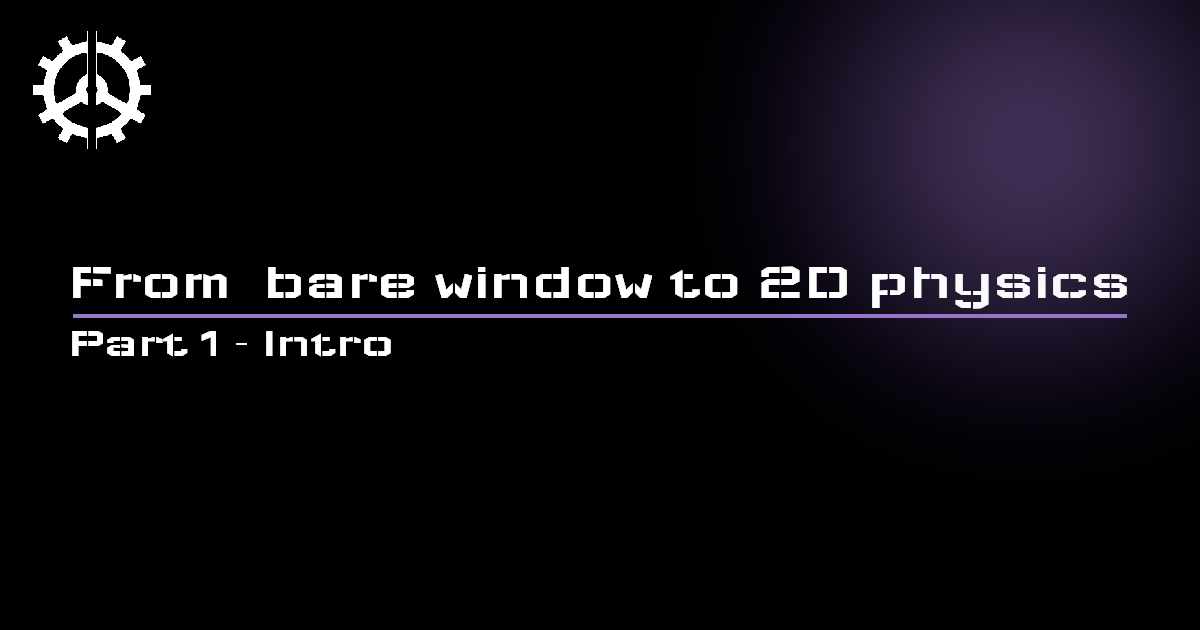From bare window to 2D physics - Part 1 Intro

WARNING
You won’t find ChatGPT’s gibber jabber sugary text here. Expect occasional satire, hand-crafted insults, and casual cursing. Enjoy
There is a time in a man’s life when he needs to make a decision. Use a game engine or build your own.
I would say it’s a very important decision. You see, the temptation to connect all the little pieces and make them work exactly as you wish, up to the smallest detail is undeniable.
I would say it’s an important decision, but I won’t. Because it’s not. You see, there is no real difference. But to see that, we need to rephrase the question.
“Should I just not finish the game or not finish the engine to the state where I can even start making a game”
See? No difference. In either case, the thing goes to the “unfinished projects, but I’ll come back to them one day, I promise!1!1!1” folder.
but flabbet
WHAT? Oh, I am so sorry, did I forget about that portfolio website made from a pre-made template, in which you have succesfully changed the photo and the colors with ChatGPT help? You’re right, here is your trophy.
Click to get it.
⬛
Okay, Where was I?
Ah, the illusion of choice.
In this series, we’ll be doing the harder one, making the game engine.
Let the rabbit hole begin
Well, not exactly, not a full blown generic game engine. More like an engineless 2D game.
We’ll go through:
Theoretical funsies, that will not go to prod
Such as:
- Creating a barebones window with OS sys-calls (Windows, Linux, MacOS)
- Rendering primitive 2D shapes
- Listening to input (mouse, keyboard), also barebones
What do you mean by “theoretical funsies, that will not go to prod?”
For the love of God. Just because this is Unhinged Cogs and we’ll do these things, it doesn’t mean you actually should do it in real-life projects.
This is where the second part comes in.
A breakdown of more realistic architecture for a 2D rendering framework
Now, this is a fun thing and not an easy one.
So, in this list you’ll find:
- GLFW/SDL - Why even Valve doesn’t bother dealing with OS stuff
- Design of a flexible graphics pipeline so it works across all major OSes and a browser.
- Skia, because you don’t want to deal with this low-level shit yourself.
Then, after that, a very exciting part:
Actually using it to make a simple 2D physics engine
While I take some responsibility for the first 2 parts, meaning that I actually know what I am talking about. The third part is going to be a wild ride, where most likely, I am doing stupid shit that somehow works. Starting with reinventing 2D collisions by using Skia, a rendering library.
And you know what? This is the best thing about all of this, all of programming. You explore these absolutely solved problems, knock the domino and ask a bunch of annoying questions. Do a much worse job than using ready-made solutions. But none of it matters, because in the worst case, you’ll fail and learn way more than expected and in the best, you’ll make something great, something you are proud of.
Welcome to Unhinged Cogs ladies and gentlemen!
What not to expect from this series
Now some important foreword before we begin.
It’s not a tutorial nor a guide on how to make a production ready framework for a game engine. It will be more like an adventure that might teach you something.
Origin of this series
Generally, I wanted to write a cell evolution simulator from scratch. I wanted to do it by utilizing Drawie - a library I wrote for PixiEditor. Basically, it exposes a windowing, input, and rendering high-level api for desktop and browser environments.
But that’s just that, no physics no scene, and GameObject logic, nothing. Just a raw window, rendering api and input support.
Writing physics turned out to be extremely interesting and challenging. I used unconventional methods, very likely worse than traditional approaches but it doesn’t matter. It forced me to think. A real challenge instead of copy-pasting algorithms from the internet.
I hope to pass my excitement and art of reinventing things to you in this series.
Anyway,
UNHINGE THE COGS